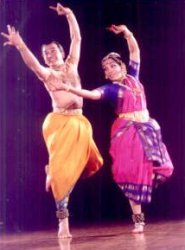ARTICLES
Dance
Natya The Essence of Hyndhava - Dharma
From "A Dancer on Dance" written by V.P. Dhananjayan, published by Bharata Kalanjali

We find the instinct to dance in the
savages as in the cultured. When dance transcends the physical, it
becomes art giving pleasure to all. Dance is a sacred art cherished
and preserved in our country for more than 2000 years. Dancing in
India is not merely a spontaneous emotion or idea translated into movement
but a long thought out and carefully fashioned ritual that needs concentrated
study and constant effort.
Mythological
Significance of Dance
The ideals
of India through ages have retained a remarkable continuity clearly recognising
between the concept of activity, the relationship between the concept of
God & Man. The Upanishads quote "DEVAM BHUTVA DEVAM YAJET' -
'become a God to worship God'. This signifies the basic idea, to
identify oneself with truth, before offering prayers to God. Various
methods of attaining this sanctity have been propounded in the Vedas and
Upanishads and the most sanctified way of worship is Sangitha.
Gitam Vadyam
Tatha Nrityam Trayam Sangitam Uchyate
Dance or Nritya
is the one in which all these aspects of creation are unified, that is
Geetham-the sound, Vadyam-the rhythm or time and Nrittam-the movement.
Brahma says, For the welfare of the generations to come I create the fifth
veda. Therefore natya is the essence of all the vedas. The
knowledge of the world from Rig Veda, music from Sama Veda, expression
from Yajur Veda and rasa or enjoyment from Atharvana Veda. Bharata
says, There is no wisdom nor knowledge, no art, no craft, no device or
action that is not to be found in Natya and in ancient India, Natyam was
a synonym for dance, drama and music.
The term
BHA-RA-THA
The name Bharata
Natyam is actually a general term for all Indian dances but has become
synonymous with the South Indian dance which was previously known as Sadir/
Chinnamelam or Dasiattam. There are a few attributes to the Bha-ra-tha.
1. That
the sage Bharatha created it.
2. That
the word is the Anagram from the first letters of Bhava, Raga and Tala.
3. That
which banishes distress. BHARAM TARAYATI ITI BHARATHA.
4. The
dance of India or Bharata Desa.
The purpose
of Dance
Apart from
spirituality or spiritual quality of dance there is a definite purpose
in dance. The purpose is to educate the illiterates, to enlighten
the literate and entertain the enlightened ones. According to gradations
of the mind, Uttama (the great one ), Madhyama (ordinary) and Adhama (the
lesser one), Natya generates morality and an awareness of well being.
It instructs and gives motivation to achieve perfection in every action.
It relaxes the mind of sick persons, distressed ones, tired souls, bereaved
family members and also the Tapaswi (sages) after their meditation.
Natya gives dharmopadesa (the path of righteousness) to happy ones, instructs
the way to praise the worthy and also to live long. Natya sharpens
the mind, increases the intellect. As such Natya gives all things
needed for the well being of the people.
Dance is also
considered to be a Yagna (sacrifice). The effect of conducting
a dance performance is shared by the audience, the sponsor and the dancer.
It is said, any auspicious occasion like child birth, marriage, rituals,
festivals and celebrations must either begin with a dance performance or
conclude with it. It has the effect of performing a hundred yagnas.
|